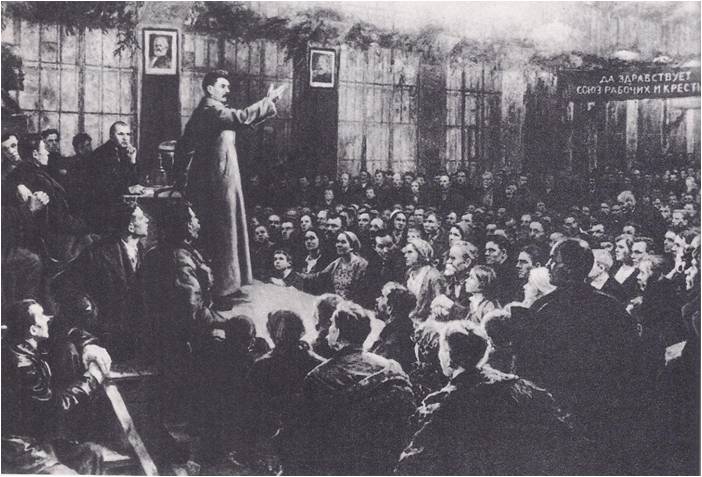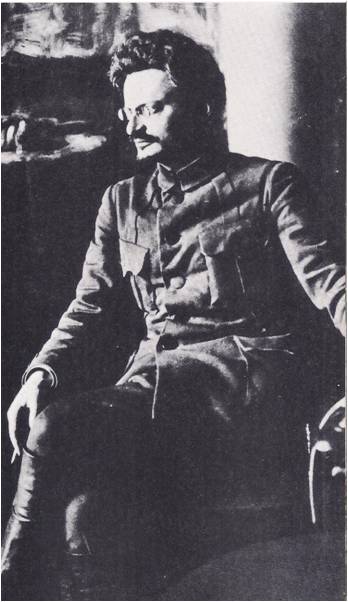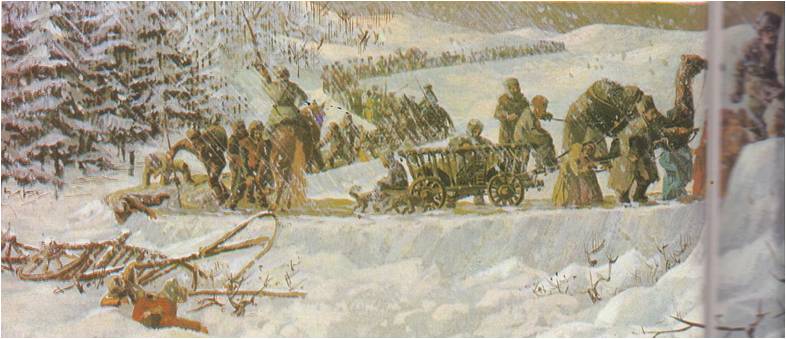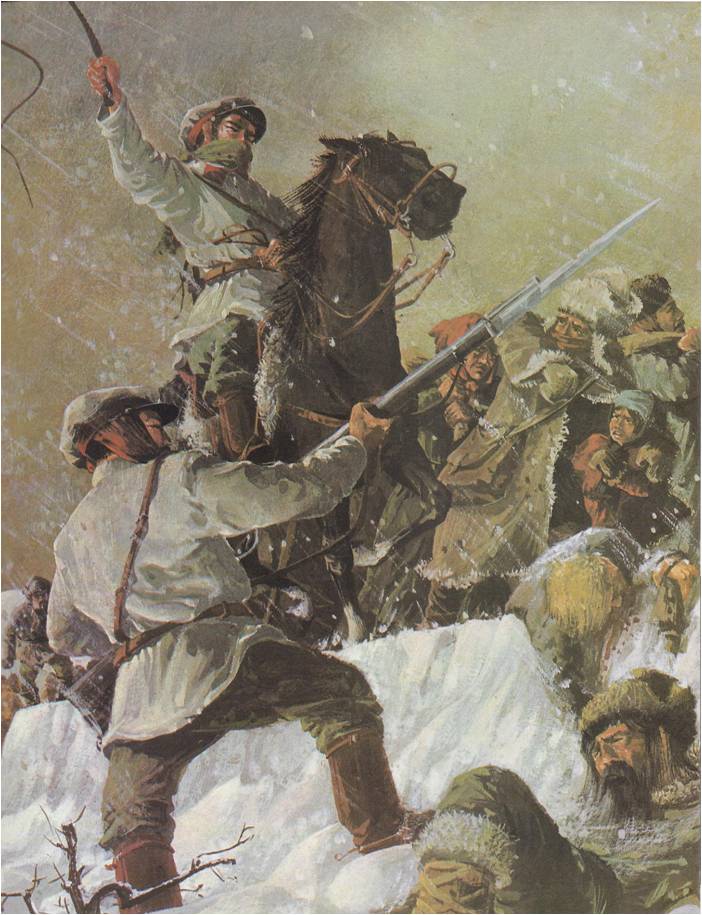AFTER THE PEACE with Germany, Lenin had hoped for a breathing spell which would give him the chance to build up his backward country. Instead, there had been civil war and it left Russia worse off than ever. Although the government had taken over all the industries, they were producing very little. A way had to be found to give the people the necessities of life, especially food. To do this, Lenin proposed to put into effect something he called the New Economic Policy, soon known as NEP. While large industries would remain in the hands of the state, small businessmen could operate on their own and peasants could sell farm products to the consumer.
To many people, including some within his party, this seemed like a return to capitalism. Lenin denied it. He said that NEP was only a temporary measure to allow the country to get back on its feet. Besides, Marxism was not a set of rules to be followed blindly. Marxists must always adapt themselves to the circumstances of life. In spite of the opposition, Lenin succeeded in winning support for his plan and the New Economic Policy was in effect from 1921 to 1928.
Food remained an urgent problem. Crops were poor in 1922 and there was famine in the land. Several million persons died of hunger and the number might have been greater if aid had not arrived from the people of the United States. Even so, the New Economic Policy was working out well. Conditions were beginning to improve and in 1923 the Communist party approved the formation of the Union of Soviet Socialist Republics. The U.S.S.R., also known as the Soviet Union, included Russia, the Ukraine, White Russia, Georgia, Armenia and Azerbaijan.

Lenin was in poor health and in 1922, after his second paralytic stroke, he could no longer take part in the government. He died on January 21, 1924 and the world wondered what would happen next in Russia. Lenin had helped to change the course of history. Many people did not like that change, but on one thing most of them agreed — Lenin had not been interested in glory and power for himself. No matter how mistaken he may have been, he had done what he believed was best for Russia and the world.
Later, Winston Churchill said of Lenin, “He alone could have found the way back. . . . The Russian people were left floundering. . . . Their worst misfortune was his birth . . . their next worst — his death.”
The big question now was: Who would take Lenin’s place? There were no laws or rules to serve as a guide in choosing a new head of the Communist party and the Soviet Union. Next to Lenin, Trotsky had been the most important person in the party and he seemed to be the natural choice. It must have seemed so to Trotsky himself, for he took no special steps to win the support of other party members. There was one man, however, who did not hesitate to play politics and line up supporters for himself. He was the General Secretary of the party and his name was Joseph Stalin.

Joseph Stalin was not, strictly speaking, a Russian. He was a native of Georgia, a land on the Black Sea that had been taken over by the tsars several centuries before. Born in 1879, he was the son of a shoemaker named Dzhugashvili. He studied to be a priest, but while still a student he became interested in Marxism. He was expelled from the religious seminary and at the age of seventeen, began working for the Social Democrats. Soon he took the name Stalin, which means “made of steel.” Unlike many other revolutionists, he spent little time in exile in foreign lands. A devoted follower of Lenin since 1903, he was arrested five times and each time he managed to escape. Then, in 1913, the tsarist government exiled him for life to Siberia, but he was released after the revolution in March of 1917. With most of the Bolshevik leaders in exile, he became one of Lenin’s most trusted representatives in Russia.
Lenin had left behind a letter in which he had written: “Comrade Stalin, having become General Secretary, has concentrated in his own hands unbounded power and I am not sure whether he will always know how to use this power cautiously enough. . . . Stalin is too rough and this fault, quite tolerable among ourselves and in dealings between us Communists, becomes intolerable in the office of General Secretary. Therefore I suggest that the comrades think of some means of displacing Stalin from this position and of naming in his stead some other man who will differ from Comrade Stalin only in this dominant characteristic, i.e.‚ will be more tolerant, more loyal, more civil and more considerate toward comrades, less capricious, etc.”

When Lenin died, Stalin was almost unknown outside his own country. Russian communists considered him a good organizer, but not much of a thinker. By skillful political maneuvering, and by using his power as general secretary of the party, Stalin made himself the real head of the party. And, because the party controlled the government, he also became the head of the Soviet Union. That was in 1924, and before long he would show that he was indeed “made of steel.” A disagreement began to develop between Stalin and Trotsky. The Bolsheviks had expected that, after Russia’s revolution, there would b similar revolutions in other parts of the world, particularly in Europe. While there had been a great deal of unrest, revolutions had taken place only in Germany and Hungary and these had been put down. The Soviet Union, as vast as it was, remained the only communist state in the world. Could communism possibly succeed in one nation that was surrounded on all sides by capitalist nations? Trotsky said that it was impossible. Unless there were revolutions elsewhere, the Soviet Union could not survive. Stalin, on the other hand, said that this was nonsense. Communism could be built in one nation and the Soviet Union would not fail. By this time, Stalin had made himself dictator and his view became the official view of the Communist party and of the government. Trotsky refused to change his mind and in 1927 he and some of his followers were expelled from the party. Early in 1929, Stalin forced Trotsky to leave the Soviet Union and go into exile.
Meanwhile, Stalin was going ahead with his program of building communism in one country. In 1928 he announced a Five-Year Plan to increase industrial production. Russia was a backward country, but Stalin proposed to bring its industry up to the level of the capitalist countries in one generation. Russia must first build up its heavy industry-power plants, steel mills, factories that produced machinery and means of transportation. Only after that had been accomplished could Russia build up the industries producing consumer goods, such as shoes, clothing and furniture. The people must do without comforts. They must make sacrifices in the present for the sake of the future, for the sake of their children’s future.
At the same time, Stalin put an end to the New Economic Policy and set up a new policy for the peasants. They could no longer work their own small plots of ground. Instead, their farms would be combined into large “collective” farms, run by the government almost like factories. Under the New Economic Policy, a number of peasants had become kulaks –– well-to-do farmers who owned their own land, implements and farm animals. Stalin intended to do away with the kulaks and took strong measures against them. The kulaks fought back in every way they could, but Stalin was determined to wipe them out. Millions were executed, imprisoned, or taken from their homes and sent to other parts of the country.

As the first Five-Year Plan drew to a close, the government announced that it was a success and immediately began another. Stalin continued to have trouble with the peasants and with farm production, but otherwise his policies seemed to be working. Politically, he was in a stronger position than ever. He had defeated Trotsky and was gaining more power every year.
Yet Stalin was not satisfied. In 1934, the world was shocked by the first of the “purge” trials. A number of old Bolsheviks were accused of plotting to overthrow the government and of having been spies or traitors. They were put on trial and strangely enough, they all publicly confessed to their crimes. The world could not help wondering why, for these were men who had sacrificed much for the revolution and had worked side by side with Lenin. Many explanations were offered — they had been tortured, their spirit had been broken by imprisonment, their families had been threatened. Whatever the reason for their confessions, they were found guilty and executed. The first purge trials were followed by others and when they were over there were few old Bolsheviks left in the government. Thousands of other less important persons were also executed or sent to prison or labour Camps. There was now no one to seriously challenge Stalin’s position. He was the dictator of the Soviet Union and the unquestioned leader of the international communist movement. Although he seldom appeared in public, pictures and statues of him were everywhere, almost like the old icons. History books were rewritten to show that he was a hero and that Trotsky and other old Bolsheviks had done little for the revolution, or had even been its enemy. The government revolved around Stalin. He liked to work late at night and so other officials also worked at night and the lights in the Kremlin burned until the early hours of morning.
Outside the Soviet Union, there were differences of opinion among students of politics about Marx’s teachings, but most agreed that he had dreamed of a better world — a world of freedom and plenty for all people. Men had fought and died — and many were still willing to fight and die — for that dream. Stalin, too, said he believed in that dream and insisted that he was following the teachings of Marx, but in the Soviet Union, under Stalin, the dream was turning into a nightmare. Marx had called for a dictatorship of the working class; the Soviet Union had a dictatorship of the Communist party and Stalin ruled the party. Marx had said that the government would in time wither away; in the Soviet Union, the government was growing stronger and Stalin ruled the government. Marx had spoken of freedom and liberty; in the Soviet Union, Stalin’s secret police spread terror and tens of thousands of people were killed or imprisoned.
Stalin gave the Soviet Union a constitution that promised democracy, but only one political party was allowed and at elections there was only a single slate of candidates. Stalin opened up opportunities for education, but he kept strict control of the schools, as well as of science and the arts. Russia no longer had a tsar. It had no aristocracy, no rich landowners, no millionaires and yet in many ways the Russia of Stalin resembled the Russia of the tsars.
At the same time, Stalin was accomplishing what he had set out to do. He was building up industry, building up the army, building up the nation. The cost in human lives and misery and suffering was enormous, but he was moulding the Soviet Union into one of the world’s great powers.




